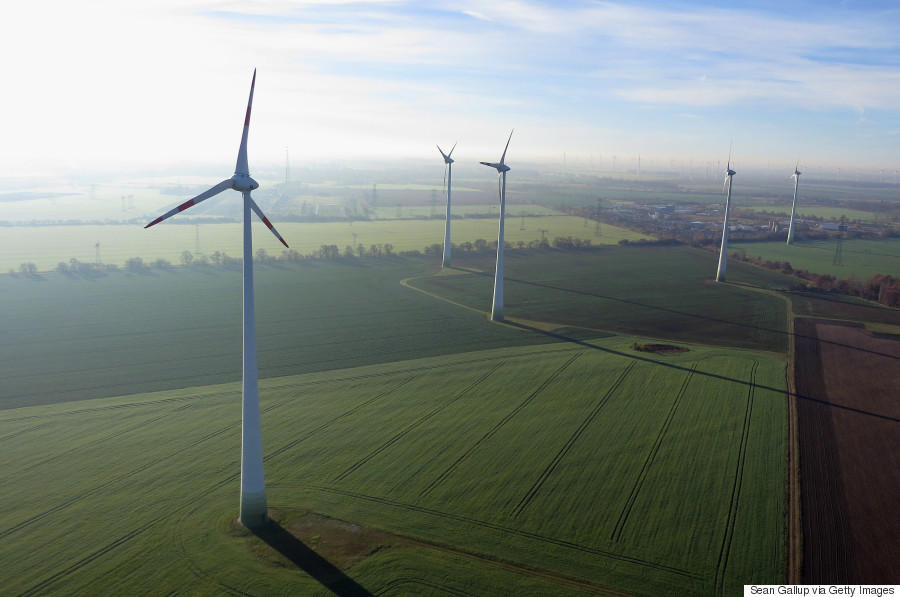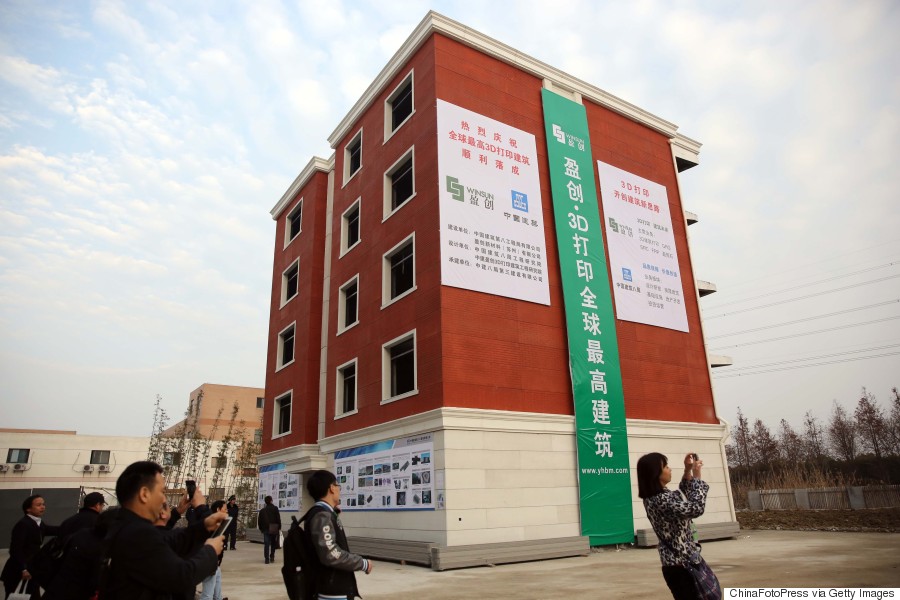 This essay is the second in a four-part series on the theme, “The Third Industrial Revolution.” An introduction by Arianna Huffington is available here. Part one is available here. Part three is here. Part four is here. Stay tuned for responses from leading global figures and technologists.
This essay is the second in a four-part series on the theme, “The Third Industrial Revolution.” An introduction by Arianna Huffington is available here. Part one is available here. Part three is here. Part four is here. Stay tuned for responses from leading global figures and technologists.
The bulk of the energy we use to heat our homes and run our appliances, power our businesses, drive our vehicles and operate every part of the global economy will be generated at near zero marginal cost and be nearly free in the coming decades. That’s already the case for several million early adopters in the European Union who have transformed their homes and businesses into micro power plants to harvest renewable energy onsite. Currently, around 25 percent of the electricity powering Germany comes from renewable energies. By 2020, the country aims to increase that to 35 percent.
The quickening pace of renewable energy deployment is due, in large part, to the plunging cost of solar and wind energy harvesting technologies. The fixed costs of solar and wind harvesting technologies have been on exponential curves for more than 20 years, not unlike the exponential curve in computing. In 1977, the cost of generating a single watt of solar electricity was more than $76. By the last quarter of 2012, the cost of generating a watt had fallen to $0.50, and by 2017 the cost is projected to fall to $0.36 per watt. After the fixed costs for the installation of solar and wind are paid back — often in as little as 2 to 8 years — the marginal cost of the harvested energy is nearly free. Unlike fossil fuels and uranium for nuclear power, in which the commodity itself always costs something, the sun collected on rooftops and the wind traveling up the side of buildings are free. In some regions of Europe and America, solar and wind energy is already as cheap, or cheaper, than fossil fuel or nuclear generated energy.
The impact on society of near zero marginal cost solar and wind energy is all the more pronounced when we consider the enormous potential of these energy sources. The sun beams 470 exajoules of energy to Earth every 88 minutes — equaling the amount of energy human beings use in a year. If we could grab hold of one-tenth of 1 percent of the sun’s energy that reaches Earth, it would give us six times the energy we now use across the global economy. Like solar radiation, wind is ubiquitous and blows everywhere in the world — although its strength and frequency varies. A Stanford University study on global wind capacity concluded that if 20 percent of the world’s available wind was harvested, it would generate more than seven times more electricity than we currently use to run the entire global economy. The Internet of Things will enable businesses and prosumers to monitor their electricity usage in their buildings, optimize their energy efficiency and share surplus green electricity generated on-site with others across nations and continents.
The Energy Internet is comprised of five foundational pillars, all of which have to be phased in simultaneously for the system to operate efficiently.
1. Buildings and other infrastructure will need to be refurbished and retrofitted to make them more energy-efficient so that renewable energy technologies — solar, wind, etc. — can be installed to generate power for immediate use or for delivery back to the electricity grid for compensation.
2. Ambitious targets must be set to replace fossil fuels and nuclear power with renewable energy sources. To achieve this goal, feed-in tariffs need to be introduced to encourage early adopters to transform buildings and property sites into micro power generation facilities. The feed-in tariffs guarantee a premium price above market value for renewable energies generated locally and sent back to the electricity grid.
3. Storage technologies including hydrogen fuel cells, batteries, water pumping, etc., will need to be embedded at local generation sites and across the electricity grid to manage both the flow of intermittent green electricity and the stabilization of peak and base loads.
4. Advanced meters and other digital technologies will need to be installed in every building to transform the electricity grid from servo-mechanical to digital connectivity in order to manage multiple sources of energy flowing to the grid from local generators. The distributed smart electricity infrastructure will enable passive consumers of electricity to become active producers of their own green electricity, which they can then use off-grid to manage their facilitates or sell back to the Energy Internet.
5. Every parking space will need to be equipped with a charging station to allow electric and fuel cell vehicles to secure power from the Energy Internet, as well as sell power back to the electricity grid. Millions of electric and fuel cell vehicles connected to the Energy Internet also provide a massive backup storage system that can send electricity to the grid during peak demand, when the price of electricity has spiked, allowing vehicle owners to be appropriately compensated for contributing their electricity to the network.
The phase-in and the integration of the above five pillars transforms the electricity grid from a centralized to a distributed electricity system, and from fossil fuel and nuclear generation to renewable energy. In the new system, every business, neighborhood and homeowner becomes the producer of electricity, sharing his or her surplus with others on a smart Energy Internet that is beginning to stretch across national and continental landmasses.

An electric car charging station in Maine. (Whitney Hayward/Portland Press Herald via Getty Images)
The democratization of energy is forcing electricity companies to rethink their business practices. A decade ago, four giant vertically integrated electricity-generating companies — E.ON, RWE, EnBW and Vattenfall — produced much of the electricity powering Germany. Today, these companies are no longer the exclusive arbiters of power generation. In recent years, farmers, urban dwellers and small and medium-sized enterprises established electricity cooperatives across Germany. Virtually all of the electricity cooperatives were successful in securing low-interest loans from banks to install solar, wind and other renewable energies onsite. The banks were more than happy to provide the loans, assured that the funds would be paid back by the premium price the cooperatives would receive — via feed-in tariffs — from selling the new green electricity back to the grid. Today, the majority of the green electricity powering Germany is being generated by small players in electricity cooperatives.
While these traditional vertically integrated power companies proved quite successful in generating relatively cheap electricity from traditional fossil fuels and nuclear power, they have not been able to effectively compete with local electricity cooperatives whose laterally scaled operations are better at managing energy harnessed by thousands of small players in broad collaborative networks. Peter Terium, CEO of RWE, the German energy company, told Reuters that a massive shift is taking place in Germany from centralized to distributed power, and said that the bigger power and utility companies “have to adjust to the fact that, in the longer term, earning capacity in conventional electricity generation will be markedly below what we’ve seen in recent years.”
A growing number of electricity-generating companies are coming to grips with the new reality of democratized energy and are changing their business models to accommodate the new Energy Internet. In the future, their income will increasingly rely on erecting and operating the Energy Internet managing their customers’ energy use. The electricity companies will mine Big Data across each of their clients’ value chains and use analytics to create algorithms and applications to increase their aggregate energy efficiency and productivity, and reduce their marginal cost. Their clients, in turn, will share the efficiency and productivity gains back with the electricity companies in what are called “performance contracts.” In short, power companies will profit more from managing energy use more efficiently and selling less rather than more electricity.
The Automated, GPS-Guided Transportation and Logistics Internet
The meshing of the Communication Internet and the Energy Internet makes possible the build-out and scale-up of the automated Transportation and Logistics Internet. The convergence of these three Internets comprise the kernel of the Internet of Things platform for managing, powering and transporting goods in a Third Industrial Revolution economy. The automated Transportation and Logistics Internet is made up of four foundational pillars, which, like the Energy Internet, have to be phased-in simultaneously for the system to operate efficiently.
1. As mentioned previously, charging stations will need to be installed ubiquitously across land masses, allowing cars, buses, trucks and trains to power up or send back electricity to the grid.
2. Sensors need to be embedded in devices across logistics networks to allow factories, warehouses, wholesalers, retailers and end users to have up-to-the-moment data on logistical flows that affect their value chain.
3. The storage and transit of all physical goods will need to be standardized so that they can be efficiently passed off to any node and sent along any passageway, operating across the logistics system in the same way that information flows effortlessly and efficiently across the World Wide Web.
4. All of the operators along the logistics corridors need to aggregate into collaborative networks to bring all of their assets into a shared logistical space to optimize the shipment of goods, taking advantage of lateral economies of scale. For example, thousands of warehouses and distribution centers might establish cooperatives to share unused spaces, allowing carriers to drop off and pick up shipments using the most efficient path on route to their destination.

Container ship Josco View of Hong Kong, and Panama’s container ship Mol Earnest sail through a port in Yokohama, southwest of Tokyo. (AP Photo/Koji Sasahara)
The Internet of Things platform will provide real-time logistical data on pick-up and delivery schedules, weather conditions, traffic flows and up-to-the-moment information on warehouse storage capacities en route. Automated dispatching will use big data and analytics to create algorithms and applications to ensure the optimization of aggregate efficiencies along the logistical routes and, by so doing, dramatically increase productivity while reducing the marginal cost of every shipment.
By 2025, at least some of the shipments on roads, railways and water will likely be carried out by driverless electric and fuel cell transport, powered by near zero marginal cost renewable energies, and operated by increasingly sophisticated analytics and algorithms. Driverless transport will accelerate productivity and reduce the marginal labor cost of shipping goods toward near zero on a smart automated Transportation and Logistics Internet.
The erection of the automated Transportation and Logistics Internet also transforms the very way we view mobility. Today’s youth are using mobile communication technology and GPS guidance on an incipient automated Transportation and Logistics Internet to connect with willing drivers in car-sharing services. Young people prefer “access to mobility” over ownership of vehicles. Future generations will likely never own vehicles again in a smart, automated mobility era. Larry Burns, the former executive vice president of General Motors and now a professor at the University of Michigan, did a study of mobility patterns in Ann Arbor, a mid-sized American city, and found that car-sharing services can reduce the cost of traveling a mile by 80 percent compared to privately owned vehicles. He also found that a “shared fleet provides almost instantaneous access to a vehicle with a fleet of only 15 percent of the number of privately owned vehicles that would have been used for these trips.”

A traffic jam in heavy smog, Beijing. (ChinaFotoPress via Getty Images)
There are currently at least a billion cars, buses and trucks crawling along around the world. Gasoline-powered internal combustion vehicles were the centerpiece of the Second Industrial Revolution. The mass production of these vehicles devoured vast amounts of the Earth’s natural resources. Cars, buses and trucks also burn massive amounts of oil and are a major contributor to global warming gas emissions. Burns’ study suggest a large number of vehicles currently on the road are likely to be eliminated with widespread adoption of car-sharing services over the course of the next generation. Those that remain will be electric and fuel cell transport, powered by near zero marginal cost renewable energy. Those shared vehicles, in turn, will be driverless and running on automated, smart road systems.
The long-term transition from ownership of vehicles to access to mobility in driverless vehicles on smart road systems will fundamentally alter the business model for the transportation industry. While the big auto manufacturers around the world will produce fewer vehicles over the course of the next 30 years, they will likely increasingly reposition themselves as aggregators of the global automated Transportation and Logistics Internet, managing mobility services and logistics.
The convergence of the Communication Internet, renewable Energy Internet, and automated Transportation and Logistics Internet in an operating kernel becomes the global brain for an Internet of Things cognitive infrastructure. This new digital platform fundamentally changes the way we manage, power and move economic activity across the numerous value chains and networks that make up the global economy. The digitalized Internet of Things platform is the core of the Third Industrial Revolution.
Distributed Manufacturing
Virtually every industry will be transformed by the Internet of Things platform and the ushering in of a Third Industrial Revolution. For example, a new generation of micro-manufacturers are beginning to plug in to the incipient Internet of Things and dramatically increasing their productivity while reducing their marginal costs, enabling them to outcompete the formerly invincible global manufacturing firms, which are organized around vertically integrated economies of scale. It’s called 3-D printing, and it is the manufacturing model that accompanies an Internet of Things economy.
In 3-D printing, software directs molten feedstock inside a printer to build up a physical product layer by layer, creating a fully formed object, even with movable parts, which then pops out of the printer. Like the replicator in the Star Trek television series, the printer can be programmed to produce an infinite variety of products. Printers are already producing products from jewelry and airplane parts to human prostheses, and even parts of cars and buildings. And cheap printers are being purchased by hobbyists interested in printing out their own parts and products. The consumer is beginning to give way to the prosumer as increasing numbers of people become both the producer and consumer of their own products.
Three-dimensional printing differs from conventional centralized manufacturing in several important ways. To begin with, there is little human involvement aside from creating the software. The software does all the work, which is why it’s more appropriate to think of the process as “infofacture” rather than “manufacture.”

Visitors tour 3-D-printed houses at Suzhou Industrial Park in China. (ChinaFotoPress via Getty Images)
The early practitioners of 3-D printing have made strides to ensure that the software used to program and print physical products remains open source, allowing prosumers to share new ideas with one another in do-it-yourself hobbyist networks. The open design concept conceives of the production of goods as a dynamic process in which thousands — even millions — of players learn from one another by making things together. The elimination of intellectual property protection also significantly reduces the cost of printing products, giving the 3-D printing enterprise an edge over traditional manufacturing enterprises, which must factor in the cost of myriad patents. The open-source production model has encouraged exponential growth.
The 3-D printing production process is organized completely differently than the manufacturing process of the First and Second Industrial Revolutions. Traditional factory manufacturing is a subtractive process. Raw materials are cut down and winnowed and then assembled to manufacture the final product. In the process, a significant amount of the material is wasted and never finds its way into the end product. Three-dimensional printing, by contrast, is additive infofacturing. Software is directing the molten material to add layer upon layer, creating the product as a whole piece. Additive infofacturing uses one-tenth of the material of subtractive manufacturing, giving the 3-D printer a dramatic leg up in efficiency and productivity. 3-D printing is projected to grow at a blistering rate in the future.
3-D printers can print their own spare parts without having to invest in expensive retooling and the time delays that go with it. With 3-D printers, products can also be customized to create a single product or small batches designed to order, at minimum cost. Centralized factories, with their capital-intensive economies of scale and expensive fixed production lines designed for mass production, lack the agility to compete with a 3-D production process that can create a single customized product at virtually the same unit cost as producing 100,000 copies of the same item.
Making 3-D printing a truly local, self-sufficient process requires that the feedstock used to create the filament is abundant and locally available. Staples — the office supply company — has introduced a 3-D printer, manufactured by Mcor Technologies in its store in Almere, in the Netherlands, that uses cheap paper as feedstock. The process, called selective deposition lamination, prints out hard 3-D objects in full color with the consistency of wood. The 3-D printers are used to “infofacture” craft products, architectural designs and even surgical models for facial reconstruction. The paper feedstock costs a mere 5 percent of previous feedstocks. Other 3-D printers are using recycled plastic, paper and metal objects as feedstock at near zero marginal cost.
Someone with a 3-D printer can also power his or her fabrication lab with green electricity harvested from renewable energy onsite or generated by local producer cooperatives. Small and medium-sized enterprises in Europe and elsewhere are already beginning to collaborate in regional green electricity cooperatives to take advantage of lateral scaling. With the cost of centralized fossil fuels and nuclear power constantly increasing, the advantage skews to small and medium-sized enterprises that can power their factories with renewable energies whose marginal cost is nearly free.
Marketing costs also plummet in an Internet of Things economy. The high cost of centralized communications in both the First and Second Industrial Revolutions — in the form of magazines, newspapers, radio and television — meant that only the bigger manufacturing firms with integrated national operations could afford advertising across national and global markets, greatly limiting the market reach of smaller manufacturing enterprises. In the Third Industrial Revolution, a small 3-D printing operation anywhere in the world can advertise infofactured products on the growing number of global Internet marketing sites at nearly zero marginal cost.

A 3-D-printed prosthetic arm is fitted to a potential user in Okayama, Japan. (Trevor Williams/Getty Images)
Plugging into an Internet of Things infrastructure at the local level gives the small infofacturers one final, critical advantage over the vertically integrated, centralized enterprises of the 19th and 20th centuries: they can power their vehicles with renewable energy whose marginal cost is nearly free, significantly reducing their logistics costs along the supply chain and in the delivery of their finished products to users.
The new 3-D printing revolution is an example of “extreme productivity.” The distributed nature of manufacturing means that anyone and eventually everyone can access the means of production, making the question of who should own and control the means of production increasingly irrelevant for a growing number of goods.
Many of Europe’s global manufacturing enterprises will continue to flourish, but will be fundamentally transformed by the democratization of manufacturing, which favors a high-tech renaissance for small and medium-sized enterprises. Europe’s manufacturing giants will increasingly partner with a new generation of 3-D-printing, small and medium-sized enterprises in collaborative networks. While much of the manufacturing will be done by SMEs that can take advantage of the increased efficiencies and productivity gains of lateral economies of scale, the giant enterprises will increasingly find value in aggregating, integrating and managing the marketing and distributing of products.
The peer-to-peer nature of the Internet of Things platform allows millions of disparate players — small and medium-sized businesses, social enterprises and individuals — to come together and produce and exchange goods and services directly with one another, eliminating the remaining middle men that kept marginal costs high in the Second Industrial Revolution. This fundamental technological transformation in the way economic activity is organized and scaled portends a great shift in the flow of economic power from the few to the multitudes — the democratization of economic life.
It is important to emphasize that the transition from the Second to the Third Industrial Revolution will not occur overnight, but, rather, take place of over 30 to 40 years. Many of today’s global corporations will successfully manage the transition by adopting the new distributed and collaborative business models of the Third Industrial Revolution while continuing their traditional Second Industrial Revolution business practices. In the coming years, capitalist enterprises will likely find more value in aggregating and managing laterally scaled networks than in selling discrete products and services in vertically integrated markets.
Jeremy Rifkin is the author of “The Zero Marginal Cost Society: The Internet of Things, the Collaborative Commons, and the Eclipse of Capitalism.” Rifkin is an advisor to the European Union and to heads of state around the world, and is the president of the Foundation on Economic Trends in Washington, D.C. For more information, please visit The Zero Marginal Cost Society.




